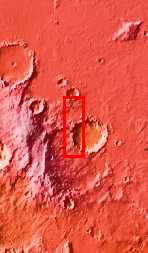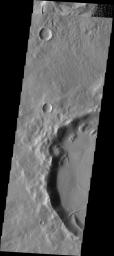
Context image for PIA10273
Channel to RidgeThis VIS image illustrates one of the complexities of studying Mars. The small channel that enters the crater appears to become a ridge as it crosses onto the crater floor. This inversion of topography is due to several processes. Initially the channel would have carved into the crater rim and onto the floor. At some time material infilled the channel on the floor of the crater. This infilling material is more resistant to erosion than the surrounding material that has subsequently been removed. So the channel fill now is topographically a ridge, but is located where the original channel cut into the crater.
Image information: VIS instrument. Latitude -35.6N, Longitude 242.8E. 17 meter/pixel resolution.
Please see the THEMIS Data Citation Note for details on crediting THEMIS images.
Note: this THEMIS visual image has not been radiometrically nor geometrically calibrated for this preliminary release. An empirical correction has been performed to remove instrumental effects. A linear shift has been applied in the cross-track and down-track direction to approximate spacecraft and planetary motion. Fully calibrated and geometrically projected images will be released through the Planetary Data System in accordance with Project policies at a later time.
NASA's Jet Propulsion Laboratory manages the 2001 Mars Odyssey mission for NASA's Office of Space Science, Washington, D.C. The Thermal Emission Imaging System (THEMIS) was developed by Arizona State University, Tempe, in collaboration with Raytheon Santa Barbara Remote Sensing. The THEMIS investigation is led by Dr. Philip Christensen at Arizona State University. Lockheed Martin Astronautics, Denver, is the prime contractor for the Odyssey project, and developed and built the orbiter. Mission operations are conducted jointly from Lockheed Martin and from JPL, a division of the California Institute of Technology in Pasadena.

 Planetary Data System
Planetary Data System













